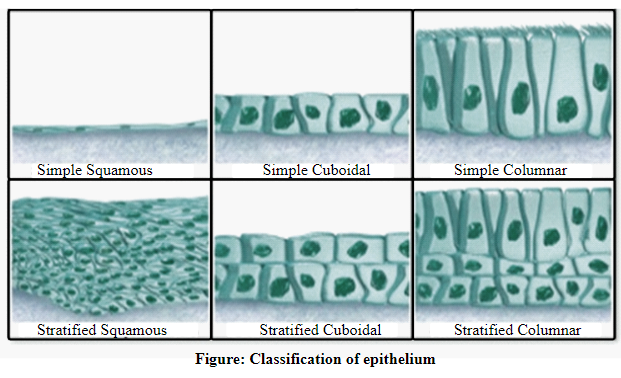
Concept explainers
Explain how connective tissues differ from epithelial tissues in structure and function.
To review:
The difference between connective tissues and epithelial tissues, based on their structure and function.
Introduction:
Tissues are a group of cells that have a specific function. In a living organism, tissues are of four types, namely, epithelial tissue, connective tissue, muscle tissue, and connective tissue. The function and structure of these tissues vary from each other.
Explanation of Solution
The difference between connective tissues and epithelial tissues is given in the following table:
| Connective tissue | Epithelial tissue |
| This group of tissues connects different tissues with each other. | Epithelial tissue is the most abundant tissue as it covers the cavities and the surface of the body. |
| They have an extracellular matrix (ECM) where cells are scattered. Fibers and ground substances, are important structural parts of ECM. | The cells are arranged in a sheet-like manner with little ECM. There are no blood vessels in epithelial tissues. |
| Connective tissues are classified into proper connective tissue and specialized connective tissue. | Based on the tissue layer, epithelial tissues can be classified into simple and stratified. Simple epithelia have a single layer, whereas stratified epithelia have more than one layer. |
| Specialized connective tissues are cartilage, bone, and blood. Proper connective tissues are again classified into loose connective tissues, dense connective tissues, reticular tissues, and adipose tissues. | They are seen in three different principal shapes, namely, squamous, columnar, and cuboidal. |
| Blood is an example of a connective tissue. It transports nutrients and oxygen to various organs. Connective tissues provide support to our skeletal system. An example of a connective tissue that provides support is cartilage and dense connective tissue. | Epithelial tissues act as a barrier against mechanical and thermal injury. The best example is skin. |
The diagrams showing the structures of different types of connective and epithelial tissues are shown below:




Thus, it can be concluded that the two tissue classifications, namely, epitheliumand connective tissues, play a major role in the defense mechanism of the body. Based on their composition, they can also be further classified into different types.
Want to see more full solutions like this?
Chapter 4 Solutions
Human Anatomy & Physiology (2nd Edition)
- List the major types of connective tissues; add the names and characteristics of their specific types.arrow_forwardThe four primary types of tissue are __________________, _________, _________, and __________________.arrow_forward___ tissues are sheetlike with one free surface. a. Epithelial b. Muscle c. Nervous d. Connectivearrow_forward
- The term tissue can apply either to one of the four primary tissue types or to a particular organs aggregate of cellular and extracellular components. (True or false?)arrow_forwardWhich of the following is not a type of connective tissue? a. bone b. blood c. the spinal cord d. tendons e. the tissue that attaches epithelial tissue to underlying structuresarrow_forward________ detects and integrates information about changes and controls responses to those changes. a. Epithelial tissue c. Muscle tissue b. Connective tissue d. Nervous tissuearrow_forward
- __________, a specialized connective tissue, is mostly plasma with cellular components and various dissolved substances. a. Irregular connective tissue b. Blood c. Cartilage d. Bonearrow_forwardTissue that contracts and is striated and involuntary would most likely be found in (a) the leg (b) the wall of the stomach (c) the exocrine glands (d) body structures requiring very rapid contraction (e) the heartarrow_forwardKnow and Comprehend 1. Tissue that contains fibroblasts and a great deal of intercellular substance is (a) connective tissue (b) muscle tissue (c) nervous tissue (d) pseudostratified epithelium (e) simple squamous epitheliumarrow_forward
 Human Biology (MindTap Course List)BiologyISBN:9781305112100Author:Cecie Starr, Beverly McMillanPublisher:Cengage Learning
Human Biology (MindTap Course List)BiologyISBN:9781305112100Author:Cecie Starr, Beverly McMillanPublisher:Cengage Learning Human Physiology: From Cells to Systems (MindTap ...BiologyISBN:9781285866932Author:Lauralee SherwoodPublisher:Cengage Learning
Human Physiology: From Cells to Systems (MindTap ...BiologyISBN:9781285866932Author:Lauralee SherwoodPublisher:Cengage Learning Biology: The Unity and Diversity of Life (MindTap...BiologyISBN:9781305073951Author:Cecie Starr, Ralph Taggart, Christine Evers, Lisa StarrPublisher:Cengage Learning
Biology: The Unity and Diversity of Life (MindTap...BiologyISBN:9781305073951Author:Cecie Starr, Ralph Taggart, Christine Evers, Lisa StarrPublisher:Cengage Learning





